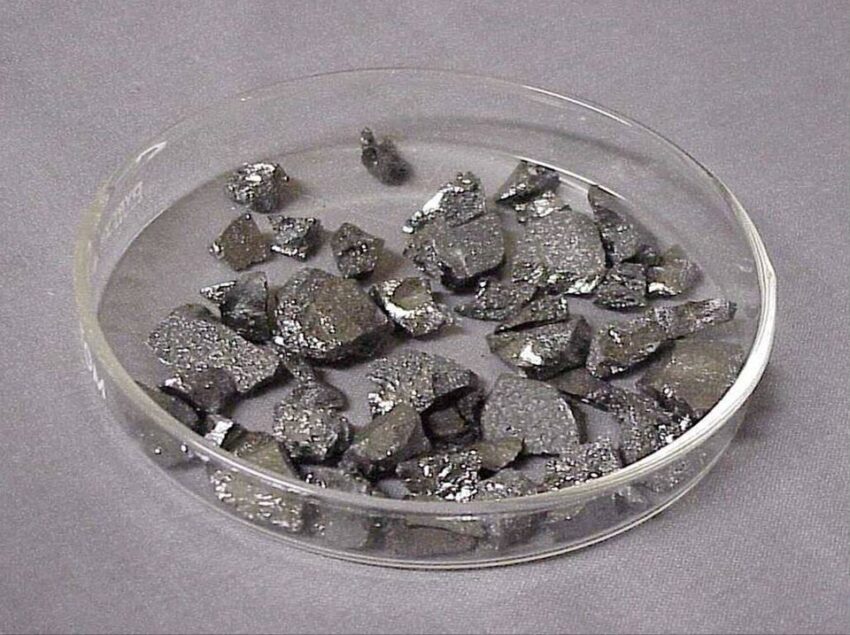Strategic and economic factors have elevated boron’s importance in recent years. The U.S. Department of Defense’s $49.6 million investment under the Defense Production Act to boost domestic boron carbide production underscores its national security significance. Growing demand from green technologies – particularly wind energy and electric vehicles – has intensified competition for supplies. Turkey’s 36% production increase through August 2024 and new facility openings demonstrate how dominant suppliers are capitalizing on this demand.
Be sure to check out all other critical raw materials (CRMs), as well.
Why Is Boron A Critical Raw Material?
Boron is classified as a critical raw material due to its unique combination of supply concentration risks, irreplaceable applications, and strategic importance across multiple industries. While the United States maintains self-sufficiency through three producers in southern California, the global supply picture reveals significant vulnerabilities. Turkey dominates world production with approximately 70% market share, operating from just a few major mines. This geographic concentration creates substantial supply chain risks, as any political, environmental, or operational disruption in Turkey could severely impact global availability. The limited number of economically viable deposits worldwide – primarily in the Mojave Desert, Turkey’s Alpide belt, and South America’s Andean belt – further compounds these supply concerns.
The criticality of boron stems largely from its essential role in modern technologies where no adequate substitutes exist. In permanent magnets, neodymium-iron-boron (NdFeB) magnets are irreplaceable in wind turbines and electric vehicles. The glass and ceramics industries depend on boron for thermal and chemical resistance properties in products ranging from smartphone screens to fiberglass insulation. High-purity boron is crucial for semiconductor manufacturing and solar panels, while agriculture requires it as an essential micronutrient for crop growth. With over 300 applications spanning from defense to detergents, the absence of viable substitutes for most critical uses makes supply security paramount.
The combination of concentrated supply, lack of substitutes, and importance across strategic industries makes boron a textbook example of a critical raw material. Both the EU and US have designated it as such, recognizing that disruptions would cascade through manufacturing sectors worth billions. While the U.S. maintains domestic production capacity and new projects like Nevada’s planned 175,000 ton/year boric acid facility offer some supply diversification, the global reliance on Turkish production and the growing demand from clean energy and defense applications ensure boron will remain a critical material for the foreseeable future.
20 Interesting Facts About Boron
- Cosmic origin: Boron is one of only three elements (along with beryllium and lithium) created primarily by cosmic ray spallation rather than stellar nucleosynthesis or the Big Bang.
- Hardest compounds: Boron forms some of the hardest known materials – boron carbide (B₄C) is the third hardest substance after diamond and cubic boron nitride, with a Mohs hardness of 9.5.
- Neutron absorber: Boron-10 has an exceptionally high neutron absorption cross-section (3,835 barns), making it crucial for nuclear reactor control rods and neutron shielding.
- Icosahedral structure: Elemental boron forms unique 12-atom icosahedral (20-sided) clusters as its basic structural unit, unlike any other element.
- Multiple allotropes: Boron has at least 16 different allotropes (structural forms), more than most elements, ranging from amorphous to various crystalline structures.
- Superhigh pressure form: Under extreme pressure (>160 GPa), boron transforms into a partially ionic phase with unusual bonding, discovered in 2009.
- Plant micronutrient: Boron is the only metalloid essential for plant growth, crucial for cell wall formation and sugar transport, with deficiency causing “hollow heart” in vegetables.
- Strongest electromagnets: Neodymium-iron-boron magnets are the strongest permanent magnets known, with magnetic field strengths up to 1.4 Tesla.
- Boron nitride versatility: BN exists in multiple forms mimicking carbon – hexagonal (like graphite), cubic (like diamond), and even nanotube structures.
- Unusual melting behavior: Boron has one of the highest melting points among metalloids (2,076°C) but anomalously low electrical conductivity that increases with temperature.
- Boranes complexity: Boron forms exotic hydrogen compounds (boranes) with “three-center two-electron bonds” that defied classical bonding theory when discovered.
- Superconductivity: Magnesium diboride (MgB₂) becomes superconducting at 39K, the highest critical temperature for a conventional BCS superconductor.
- Borophene: Two-dimensional boron sheets (borophene) were synthesized in 2015, showing metallic properties unlike bulk boron’s semiconducting nature.
- Nuclear medicine: Boron neutron capture therapy uses boron-10 to selectively destroy cancer cells when exposed to thermal neutrons.
- Flame color: Boron compounds burn with a characteristic bright green flame, used in pyrotechnics and as a qualitative test for boron.
- Glass transformation: Adding just 1% boron oxide to glass reduces its thermal expansion coefficient by 33%, creating borosilicate glass.
- Meteorite indicator: The boron/beryllium ratio in meteorites helps determine their exposure time to cosmic rays during space travel.
- Quantum properties: Boron exhibits unusual quantum mechanical behavior in its bonding, with electron-deficient bonds that sparked development of molecular orbital theory.
- Isotope separation: Natural boron’s two isotopes (¹⁰B at 20%, ¹¹B at 80%) have one of the largest relative mass differences, making separation relatively easy.
- Prehistoric preservative: Boron compounds have natural biocidal properties and were unknowingly used by ancient Egyptians in mummification (from natron deposits containing borates).
Thanks for reading!
